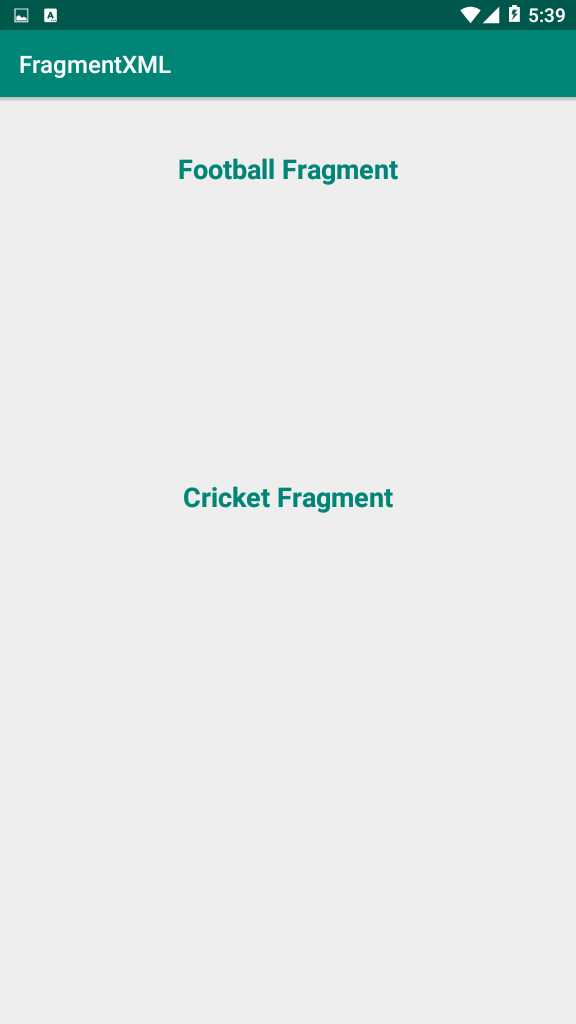

- ANDROID STUDIO FRAGMENT FULL
- ANDROID STUDIO FRAGMENT ANDROID
When the Add Fragment button is pushed, a simple Fragment containing only a TextView (background in orange) displaying the current time in milliseconds is added to the LinearLayout of the current Activity.
ANDROID STUDIO FRAGMENT FULL
The full Eclipse project of the demo is available here.
show(fragment): Shows a previously hidden Fragment.Īs a simple example, I have provided a demo application that adds and removes a Fragment with the push of a button on an Activity. This is essentially the same as calling remove(fragment) for all currently added fragments that were added with the same containerViewId and then add(containerViewId, Fragment). Replace(containerViewId, fragment): Replace an existing fragment that was added to a container. remove(fragment): Remove an existing Fragment. Only relevant for Fragments whose views have been added to a container. hide(fragment): Hides an existing Fragment. detach(fragment): Detach the given Fragment from the UI (the Fragment is removed from the UI, however its state is still being actively managed by the FragmentManager). attach(fragment): Re-attach the specified Fragment from the UI after it had previously been deatched (with call to detach). add(containerViewId, fragment_instance): Add a fragment to the Activity state with the identifier of the container this Fragment is to be placed in and the Fragment to be added. See the API documentation for more details, but the list below outlines a number of the important methods on FragmentTransaction. You can also replace one Fragment with another, show or hide a Fragment (actually this is to show or hide the visible View components tied to the Fragment as Fragments of themselves have no direct visible representation), attach or detach a Fragment, and more. Example here of adding.įragmentTransaction.add (R.id.myFrame, myFrag) Īdding and removing fragments is only a portion of the changes that can be accomplished with the FragmentManager/FragmentTransaction. work here to change Activity fragments (add, remove, etc.). FragmentManager fragmentManager = getFragmentManager () įragmentTransaction fragmentTransaction = fragmentManager.beginTransaction () The method commit( ) is used to asynchronously invoke the Fragment changes on the Activity. 

Get or “start” the FragmentTransaction direct from the FragmentManager instance by calling beginTransaction( ). Transactions for Fragment changes to an Activity are established and committed (or undone/rolledback) via the FragmentTransaction instance. A collection of Fragment changes made to an Activity that are to be done at the same time are created inside of a transaction. Obtain the FragmentManager by calling getFragmentManager( ) in an Activity.
ANDROID STUDIO FRAGMENT ANDROID
Simply stated and per the Android documentation, a FragmentManager manages the fragments in an Activity. To programmatically add or remove a Fragment, you will need the FragmentManager and FragmentTransaction instances. However, as with View components, Fragments can be programmatically added to or removed from a containing View in the Activity without being defined in the Activity’s layout. Fragments also provide a means to create reusable portions of UI display/functionality.Īn Activity’s layout can include Fragments as shown below. screen size, screen density, rotation, etc.). Thanks for making the long trip guys and thanks to all my students (local and long distance) last week for your attendance and participation.ĭuring last week’s class, my students learned that Fragments (since Android 3) can be used to organize the display of information in Activities, especially those that have to deal with multiple device form factors (i.e. all the way from Turkey and Joshua and Doug came up from Mason City, Iowa. Some came a very long way to learn Android. I had another great class of soon-to-be Android engineers in my class last week.







 0 kommentar(er)
0 kommentar(er)
